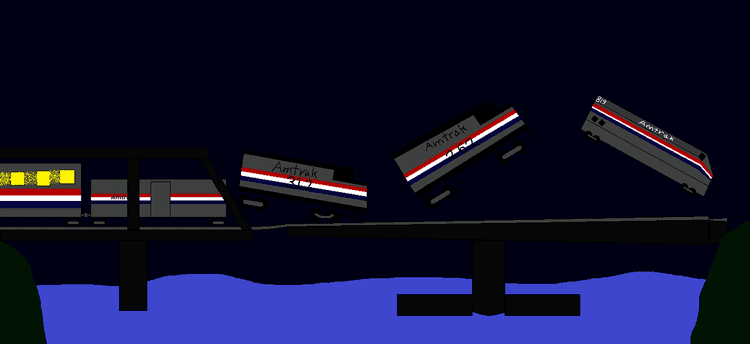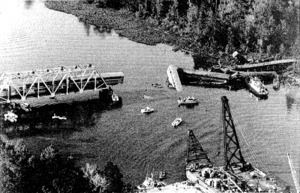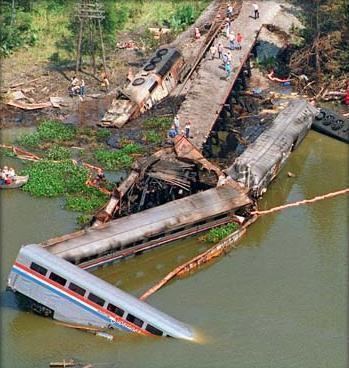Time 2:53 am Rail line CSX Transportation Trains 1 Total number of deaths 47 Injuries 103 | Country United States Type of incident Derailment Date 22 September 1993 Operator Amtrak Location Mobile | |
Cause Barge collision with bridge / wrong design Location Mobile, Alabama, United States Similar 1987 Maryland train colli, 1995 Palo Verde - Arizona d, I‑40 bridge disaster, Ashtabula River railroad d, Eschede derailment | ||
The 1993 Big Bayou Canot train wreck was the derailing of an Amtrak train on the CSXT Big Bayou Canot bridge in northeastern Mobile, Alabama, United States, on September 22, 1993. It was caused by displacement of a span and deformation of the rails when a tow of heavy barges had collided with the bridge eight minutes earlier. Forty-seven were killed and 103 were injured. To date, it is both the deadliest train wreck in Amtrak's history and the worst rail disaster in the United States since the 1958 Newark Bay, New Jersey rail accident in which 48 lives were lost.
Contents
Events

The CSX Transportation unfinished swing bridge over the Big Bayou Canot in southwestern Alabama (about 10 miles northeast of Mobile) was struck at approximately 2:45 a.m. by a barge being pushed by the towboat Mauvilla (owned and operated by Warrior and Gulf Navigation of Chickasaw, Alabama), whose pilot had become disoriented in heavy fog. The collision forced the unsecured end of a bridge span approximately three feet out of alignment, into the path of an oncoming train, and severely kinked the track.

At 2:53 a.m., Amtrak's Sunset Limited train, powered by three locomotives (one GE Genesis P40DC number 819 in the front, and two EMD F40PHs, numbers 262 and 312) en route from Los Angeles, California to Miami, Florida with 220 passengers and crew aboard, crossed the bridge at around 70 mph and derailed at the kink. The first of its three locomotives slammed into the displaced span, causing that part of the bridge to collapse into the water beneath. The lead locomotive embedded itself nose-first into the canal bank, and the other two locomotives, together with the baggage car, dormitory car and two of the six passenger cars, plunged into the water. The locomotives' fuel tanks, each of which held several thousand gallons of diesel fuel, ruptured upon impact, resulting in a massive fuel spill and a fire. Forty-seven people, 42 of whom were passengers, were killed, many by drowning, others by fire/smoke inhalation. Another 103 were injured. The towboat's four crew members were not injured.

Immediately prior to the accident, the Mauvilla had made a wrong turn and entered an un-navigable channel of water heading to the bridge. The towboat's pilot, Willie Odom, was not properly trained on how to read his radar and thus, owing to the very poor visibility in the fog and his lack of experience, did not realize that he was off course. The boat also lacked a compass and a chart of the waters. Odom believed that he was still on the Mobile River and had identified the bridge in the radar as another tug boat. He was not found to be criminally liable for the accident.

The bridge span had actually been designed to rotate so it could be converted to a swing bridge by adding suitable equipment. No such conversion had ever been performed, but the span had not been adequately secured against unintended movement. Despite the displacement of the bridge, the continuously welded rails did not break. As a result, the track circuit controlling the bridge approach block signals remained closed (intact) and the nearest signal continued to display a clear (green) aspect. Had one of the rails been severed by the bridge's displacement, the track circuit would have opened, causing the approach signal to display a stop (red) aspect and the preceding signal an amber approach indication. This might have given the Amtrak engineer sufficient time to stop his train or at least reduce speed in an effort to minimize the severity of the accident.
Fatal delay
An episode of the National Geographic Channel documentary series Seconds from Disaster examined the accident. In addition to corroborating findings of the official accident report, the program noted that the train had been delayed in New Orleans, Louisiana, by repairs to an air conditioner unit. This had put the train a half-hour behind schedule. If not for the delay, the Sunset Limited would have passed over the Big Bayou Canot bridge 20 minutes before the structure was struck by the barge.
Official recommendations
As a result of its investigation of this accident, the National Transportation Safety Board (NTSB) made a comprehensive series of recommendations, on September 19, 1994, to the U.S. Department of Transportation, the U.S. Army Corps of Engineers, the U.S. Coast Guard, the National Railroad Passenger Corporation (Amtrak), the Federal Emergency Management Agency, The American Waterways Operators, Inc., the Warrior & Gulf Navigation Company, the Association of American Railroads, and the American Short Line Railroad Association.
Following a recommendation to maintain a record of onboard passenger numbers, Amtrak now records passenger lists electronically.
